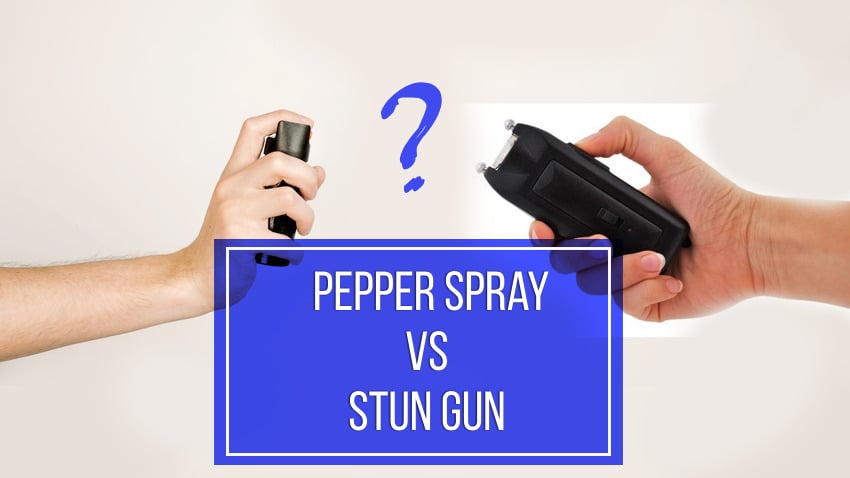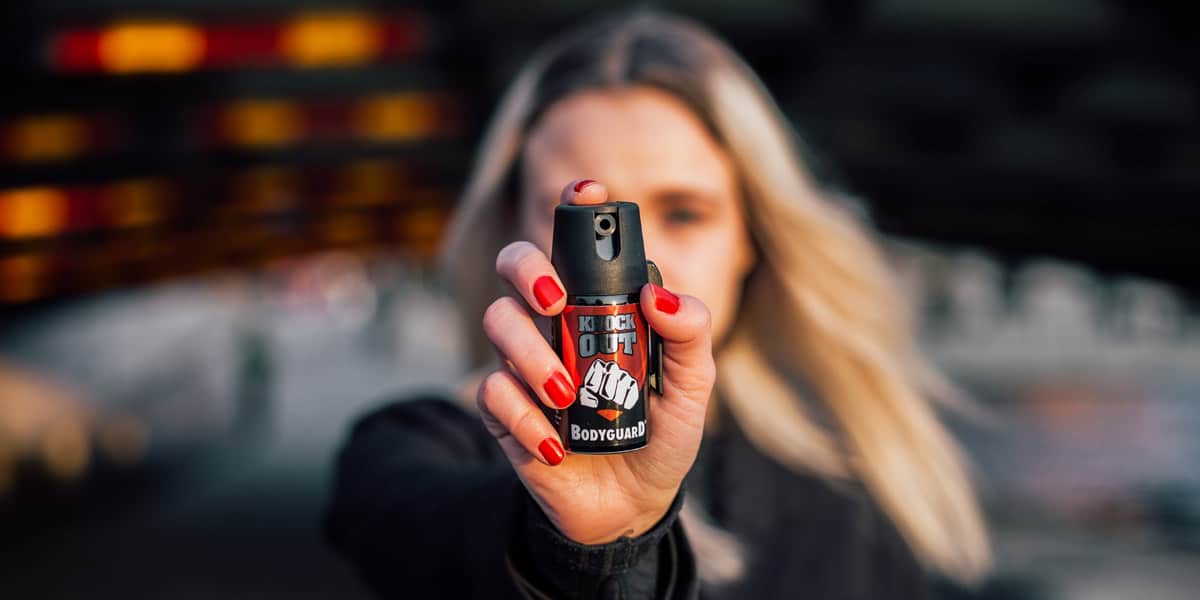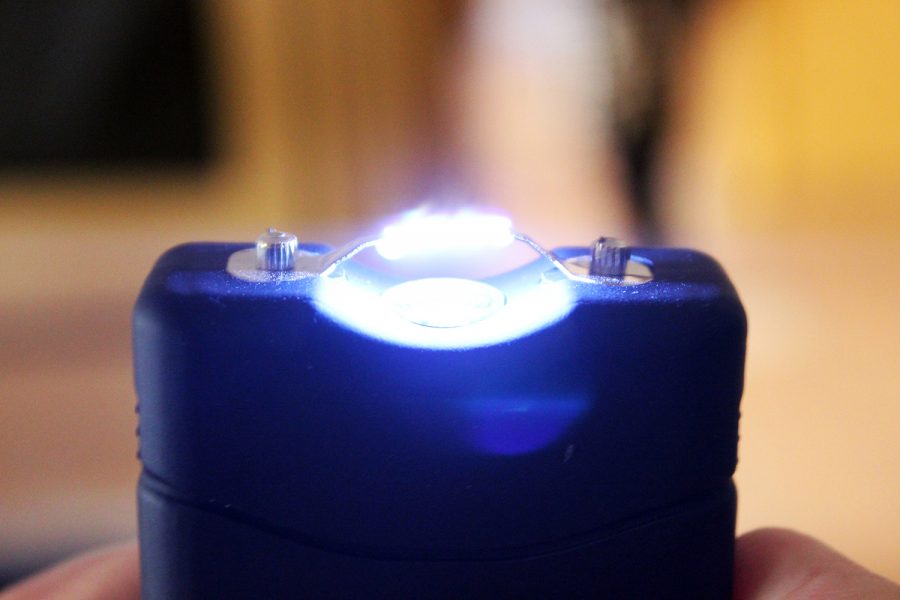
Last Updated on
We all wish we lived in a safer world, but some things are just beyond our control. And yet, some are within it, like your personal safety. Self-defense is a vital aspect of personal safety in our increasingly unpredictable world. Stun guns and pepper sprays are two of the most common non-lethal self-defense tools available today and for good reason. Both have proven to be effective means of protection, but they operate based on different principles. In this article, we’ll take a look at a friendly confrontation: stun gun vs pepper spray. We’ll compare them across several aspects to help you decide which one might be better suited for your needs.
Table of Contents
Stun Gun vs. Pepper Spray: The Basics
Ease of Use
Longevity
Effective Distance
Immobilization Effect
Safety
Discretion
Price
Legality
Limitations
FAQs

Stun Gun vs. Pepper Spray: The Basics
Pepper spray and stun guns are both non-lethal devices designed for personal protection, but they operate on different principles and have varying degrees of effectiveness depending on the situation.
A stun gun is an electronic device that disrupts the body’s neuromuscular system through a high-voltage, low-amperage electrical shock. The stun gun must be applied directly to the attacker, requiring you to be within arm’s length. The electrical shock temporarily paralyzes the attacker, giving you a chance to get away.
Pepper spray is a self-defense tool that uses a derivative of hot chili peppers. When sprayed into the face of an assailant, it causes severe irritation to the eyes, nose, mouth, and skin, resulting in temporary blindness, difficulty breathing, intense burning sensations, and other discomforts. This gives you time to escape or seek help. Pepper spray is generally contained in small aerosol cans and can reach an attacker from several feet away.
While both devices are effective for personal defense, their appropriateness depends on several factors including the specific situation, your comfort level with the device, and local laws governing their use.
Now, let’s get down to the stun gun vs pepper spray comparison part.
Ease of Use
When it comes to ease of use, both pepper sprays and stun guns are designed to be user-friendly, but there are distinct differences between the two that could influence a person’s preference.
Stun guns require direct contact with the assailant to be effective. This means you must be within arm’s reach of the attacker, which could potentially put you at greater risk. Using a stun gun requires a bit more courage as you have to physically touch the attacker with the device. However, some models of stun guns have added features like flashlights and targeting lasers to aid in use, and they often have a simple trigger mechanism.
Pepper spray operates much like a can of spray paint or hairspray – you just point and press the button. The challenge lies in aiming accurately, especially under duress. However, most pepper sprays produce a fairly wide spray pattern, which can help compensate for less-than-perfect aim. Another advantage is that pepper spray can be used from a distance, often up to several feet, allowing you to disable an attacker without having to come into close physical contact.
In summary, while both devices are relatively simple to use, pepper spray offers the advantage of range, potentially keeping you safer from physical harm. A stun gun requires close proximity but can be more immediately incapacitating when successfully applied. The choice between the two often comes down to personal comfort and the perceived threat level.
Longevity
Longevity is an important aspect of a stun gun vs pepper spray clash. This refers to both the lifespan of the device itself and the duration of its effects.
Stun guns can last for many a year and do not have an expiration date. They are usually powered by rechargeable batteries or replaceable battery packs. Like with any other electronic device, their longevity can be affected by factors like frequency of use, care, and the quality of the components.
Pepper sprays, on the other hand, typically have a shelf life of about 3 to 4 years from their manufacturing date, after which they should be replaced even if they haven’t been used. That is because the potency of the active ingredient can decrease over time, reducing its effectiveness. With time, spray canisters will also lose pressure resulting in a weaker spray. Additionally, once a pepper spray canister has been used, it cannot be refilled and must be replaced. That’s not the case for pepper ball guns, but they are sort of a whole different thing.
Effective Distance
Effective distance refers to the range from which each device can be used effectively. It’s another important aspect to consider since it determines whether you can protect yourself from a distance or have to wait to be in melee with the attacker.
Stun guns are contact weapons, meaning they require direct contact with the assailant to be effective. To use a stun gun, you must be within arm’s reach of your attacker. While this close-proximity use can be a disadvantage in certain situations, a stun gun can deliver a powerful electric shock that can immediately immobilize an attacker. You also don’t need to aim for the face – any body part will suffice. In short, while pepper spray offers the advantage of range, a stun gun can be more immediately incapacitating when used at close range.
In contrast to stun guns, pepper sprays have a longer effective range. Most pepper sprays can be effectively used from a distance of about 10-12 feet, though some products may offer a slightly longer or shorter range. That allows you to incapacitate an attacker from a safe distance, minimizing the risk of physical harm to yourself. However, the increased effective distance means you’ll have to be pretty accurate to affect the attacker.
Immobilization Effect
Immobilization of the attacker is the whole point of getting a self-defense tool. Most people opt for them to avoid possible complications of using a firearm both in terms of consequences and needed training. For that reason, it’s crucial to consider how exactly you want to stop the assailant.
Stun guns, in contrast, work by delivering a high-voltage, low-amperage shock that disrupts the body’s neuromuscular system. That causes a temporary loss of voluntary muscle control, effectively immobilizing the attacker. The immediate effects of a stun gun are typically short-lived, lasting only as long as the shock is being applied, but the resulting disorientation can last several minutes longer, providing an opportunity for escape.
Pepper spray works by causing severe irritation to the eyes, respiratory system, and skin. It leads to temporary blindness, difficulty breathing, intense burning sensations, and other discomforts. This not only disorients the attacker but also physically incapacitates them for a while. The effects can last from 15 to 45 minutes depending on the strength of the spray and the individual’s reaction to it.
It’s important to note that while both tools are designed to temporarily incapacitate an attacker, their effectiveness can be influenced by a variety of factors. Individual’s size, physical condition, determination, as well as accuracy and decisiveness of application all matter. As such, neither tool can guarantee complete immobilization in every situation, and they are better used as part of a broader personal safety strategy.
Safety
Safety is a paramount consideration. You don’t want the very thing that was meant to protect you to make you an easier target instead. Both devices are designed to deter or incapacitate an attacker, but each carries its own inherent risks, even if small.
Stun guns are generally safe for users as they do not have the potential to inadvertently affect the user or bystanders, as the electrical shock is localized to wherever the prongs make contact. However, the shock delivered by a stun gun is quite powerful. It could potentially cause more serious injury, particularly if the device is used excessively or the person has underlying health conditions.
Pepper spray is also considered safe for the user as long as it is used correctly. However, it has the potential to affect both the user and bystanders if the spray is carried by the wind or used in a confined space. It’s important to aim carefully and avoid spraying into the wind to minimize this risk. Additionally, while the effects of pepper spray are temporary and not typically life-threatening, they can be severe, particularly for individuals with respiratory issues. Not that you should worry about your attacker being an asthmatic, but if you yourself suffer from these issues, you might want to opt for a stun gun just as a precaution.
Discretion
Our stun gun vs pepper spray collision proceeds to the next stage where concealability is a must. Discretion can be an important factor when choosing a personal defense tool. That refers to how inconspicuous and easy to carry the device is as well as how unobtrusive it is to use.
Stun guns vary greatly in size and conspicuousness. Some are compact and designed to look like ordinary objects, such as flashlights or cell phones, making them relatively discreet to carry. Others are larger and don’t conceal their nature. When a stun gun is used, it produces a loud crackling noise and visible electrical arc, which can be both a deterrent and a draw of attention.
Pepper sprays tend to be quite discreet. They’re typically small enough to fit in a purse, pocket, or on a keychain, and don’t necessarily look like a weapon at first glance. Many pepper sprays are designed to look like everyday items, such as lipstick or a pen, further enhancing their discretion. When used, however, pepper spray can be quite noticeable due to the strong odor and visible cloud it produces. But at that moment, discretion will probably be the smallest of your concerns.

Price
You can’t really put a price tag on the feeling of being able to protect yourself, but the means of acquiring it do have a price. Luckily, pepper sprays and stun guns both are pretty affordable.
Stun gun prices may range significantly. Prices can range from around $20 for a basic model to several hundred dollars for high-end models with additional features like flashlights, alarms, or enhanced battery life. However, unlike pepper spray, stun guns are reusable. They’re typically powered by rechargeable batteries, so there’s no need to replace the entire device after use, just recharge it.
Pepper sprays are generally less expensive than stun guns. A basic canister of pepper spray can cost anywhere from $6 to $50, depending on the brand, size, and additional features such as UV marking dye or tear gas. However, it’s important to note that pepper spray canisters are not refillable. Once used, even if only a small amount was sprayed, they are recommended to be replaced to ensure you always have the maximum available volume for defense. It’s not a must, of course, but better be safe than sorry.
Legality
The legality of carrying and using pepper sprays and stun guns varies significantly across different jurisdictions, which makes it a crucial aspect to consider when comparing these two self-defense tools.
The laws surrounding stun guns are generally more restrictive than those for pepper spray. While they are legal to own in many places, some states (Hawaii, Rhode Island) and cities in the U.S. completely prohibit their possession. In other areas, you may need a permit or license to carry a stun gun, and there may be restrictions on where you can carry it. Some places also have laws regarding the visible carrying of stun guns.
Pepper sprays, on the contrary, are legal for adults to purchase, possess, and use as a self-defense tool. However, there are often restrictions on the size of the canister, the concentration of the active ingredient (OC), and the age of the person who can legally carry it. For example, some states in the U.S. only allow canisters of a certain size, while others require purchasers to be at least 18 years old. In some areas, you may need a permit or have to register with local law enforcement to carry pepper spray.
Limitations
Each weapon has its limitations. All of them have already been discussed, but it won’t hurt to give them a quick look once again.
Pepper Spray:
- Range: Pepper spray typically has a limited range, usually around 10-12 feet. It is a considerable distance, but if an attacker is beyond it, the spray may not reach them.
- Environmental Factors: Wind can blow the spray back towards you or spread it to unintended targets (if somebody comes to your rescue). Using pepper spray in confined spaces can also potentially affect you or bystanders.
- Accuracy: You need to aim accurately to hit the attacker’s face for maximum effectiveness. Stress and panic during an attack can affect your ability to aim correctly.
- Variable Effectiveness: The effects of pepper spray can vary based on the individual. Some people may be more resistant to its effects due to various factors such as drug or alcohol use, mental health conditions, or even a high tolerance to pain.
Stun Guns:
- Close Contact: To use a stun gun effectively, you must be within arm’s reach of your attacker. This close proximity can put you at greater risk.
- Single Target Limitation: Stun guns are designed to incapacitate one individual at a time. If faced with multiple threats, a stun gun might not provide adequate defense.
- Physical Strength: Although stun guns can cause temporary paralysis, an attacker’s size, clothing, and overall physical condition can diminish its effectiveness.
- Battery Dependency: Stun guns are battery-powered. If the battery is low or dead, the device will be either less effective or unworking.
Conclusion
As you can see, there is no apparent winner in the stun gun vs pepper spray fight. We know it’s a cliché, but your choice should be reasoned by a wide variety of factors like personal preference, budget, and local laws. If you decide to purchase either of these weapons, make sure to familiarize yourself with all safety protocols associated with their use as well as any relevant legal restrictions. Always remember that pepper sprays and stun guns are tools to be used in emergencies only and should never be considered a substitute for common sense. Remember: your safety is in your own hands.
FAQs
What are the main differences between stun guns and pepper sprays?
Stun guns are contact weapons that disable attackers by sending a high-voltage, low-amperage shock to their bodies. Pepper sprays incapacitate attackers by causing severe eye and skin irritation and difficulty breathing.
Are there any legal restrictions concerning stun guns or pepper sprays?
Yes, there are some, but the legality varies greatly by location. Some places may require permits, impose age restrictions, or even completely prohibit their use. For example, stun guns are illegal to own in Hawaii and Rhode Island whereas all states authorized the use of pepper sprays.
How long do stun guns and pepper sprays incapacitate?
If the stun gun is applied for one to two seconds, it can cause pain and muscle contractions. If the stun gun is applied for three to five seconds, it can cause the assailant to lose balance and muscle control. The effects could last several minutes, enough time for the user to escape danger. Pepper spray causes severe irritation and temporary blindness when it comes into contact with a person’s eyes. The effects usually kick in almost immediately and can last from 20 minutes to an hour.




Leave a Reply